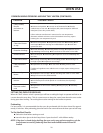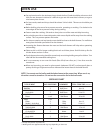
19
OVEN USE
PREHEATING
Preheating takes about 10 to 15 minutes depending on the temperature set. Preheating is necessary
for baking. The oven heating light will turn off when the oven has reached temperature. It is not
necessary to preheat for roasting. Selecting a temperature higher than desired will NOT preheat the
oven any faster, and may have a negative effect on baking results.
SETTING THE OVEN FOR BAKING
Decide if you are going to use BAKE or CONVECTION BAKE. These cooking modes are for baking,
roasting or warming using one,two or three racks. If you are going to use regular Bake,simply push in
the “BAKE” switch on the valve panel, above the large oven knob and turn the control knob to the
temperature used in the recipe. To use Convection Bake push the convection switch (located on the
control panel) and turn the control knob to the temperature desired.
1) Press BAKE or CONVECTION BAKE Selector switch.
The convection fan will turn on if “CONVECTION BAKE”is selected.
2) Set desired Temperature on Thermostat Control Knob.
The “OVEN ON”light turns on.
The “HEATING” light turns on.
Once the “HEATING”light cycles off the first time,the oven is preheated.
The “OVEN ON”light remains on until the “OFF”Selector switch has been
pushed,or the Thermostat has been turned to the “OFF”position.
High Altitude Baking
Recipes and baking times vary if you are baking at a high altitude. For accurate information write to
the Agriculture Extension Service, Colorado State University, Fort Collins, Colorado 80521. Specify the
type of information and the baking mode (convection bake or bake) you need i.e. cakes, cookies,
breads,etc. There may be a cost for the bulletins.
Pans too close or touching each other or oven walls. Batter uneven in
pans.
Temperature set too low or baking time too short. Oven not level.
Undermixing. Too much liquid.
Temperature set too high. Baking time too long. Overmixing. Too
much flour.
Pans touching each other or oven walls. Incorrect rack position.
Too much shortening or sugar. Too much or too little liquid.
Temperature set too low. Old or too little baking powder. Pan too small.
Oven door opened frequently. Added incorrect type of oil to cake mix.
Added additional ingredients to cake mix or recipe.
Incorrect rack position. Oven door not closed properly. Door gasket
not sealing properly or properly attached to door.
Incorrect use of
aluminum foil.
Oven not preheated. Pans darkened,dented or warped.
For optimum results,bake on one rack.If baking cakes on two racks,stagger the
cake pans to ensure proper air flow.Check picture on page 14.
Cakes are uneven.
Cake high in middle.
Cake falls.
Cakes, cookies,
biscuits
don’t brown evenly.
COMMON BAKING PROBLEMS AND WHY THEY HAPPEN
PROBLEM POSSIBLE CAUSES


















